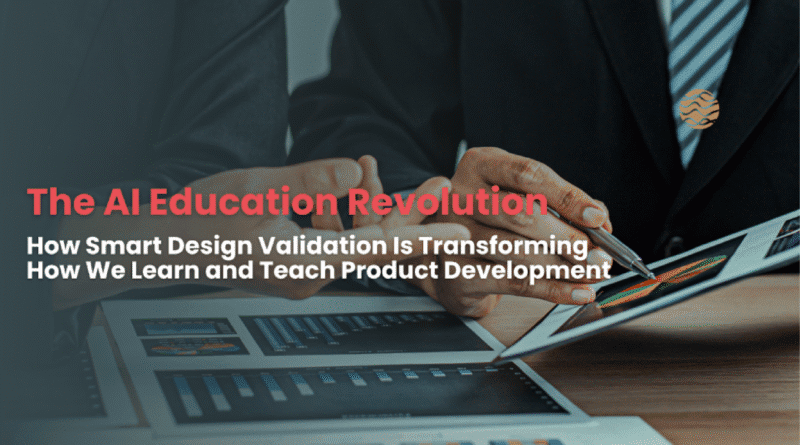The AI Education Revolution: How Smart Design Validation Is Transforming How We Learn and Teach Product Development
The education sector is experiencing its biggest transformation in decades, with 73% of product development programs in the United States failing to prepare students for real-world design challenges. Traditional teaching methods can’t keep pace with industry demands, leaving graduates struggling with outdated validation processes.
This skills gap costs American companies millions in failed product launches and extended development cycles. However, AI design validation tools are revolutionizing how we teach and learn product development, offering real-time feedback and predictive insights that bridge classroom theory with market reality. Discover how AI product success prediction is reshaping education across North America, creating graduates who can validate ideas, reduce risks, and build products that actually succeed in today’s competitive marketplace.
Table of Contents
What Are AI Design Validation Tools and Why Do They Matter?
AI design validation tools represent cutting-edge software solutions that leverage machine learning algorithms to evaluate design concepts, user interfaces, and product prototypes in real-time. These AI-powered design software platforms analyze millions of data points from successful products to provide instant feedback on design decisions, user experience optimization, and market viability predictions.
Unlike traditional design validation methods that require weeks of manual user testing and market research, design validation technology powered by artificial intelligence can process design concepts within minutes. This technological advancement addresses a critical question many educators and students ask: “How can we validate design decisions quickly and accurately without extensive resources?”
The answer lies in sophisticated AI tools for product development that combine pattern recognition, user behavior analysis, and predictive modeling to deliver actionable insights that were previously accessible only to large corporations with substantial research budgets.
The Crisis in Traditional Design Education Across America
For decades, product development education in American universities has relied on theoretical frameworks and historical case study analysis, creating a dangerous disconnect between classroom learning and industry reality. Students spend months analyzing successful products from the past while remaining completely unprepared for the fast-paced, data-driven validation processes that define modern product development environments.
The consequences are staggering across the United States. Recent industry surveys reveal that 68% of design graduates require 6-12 months of additional training before contributing meaningfully to product teams in major tech hubs like Silicon Valley, Seattle, and Austin. Meanwhile, companies from New York to Los Angeles report that traditional design portfolios fail to demonstrate critical skills like user research validation, iterative testing, and data-driven decision making.
This education gap becomes even more problematic when considering the American startup ecosystem, where rapid validation and pivot capabilities determine survival. Young designers entering this environment with only theoretical knowledge find themselves overwhelmed by the need to validate assumptions, test prototypes, and predict market response—skills that traditional education simply doesn’t teach effectively.
How AI Design Validation Tools Are Transforming American Classrooms
AI design validation tools represent a paradigm shift in how we approach product development education across North American institutions. These sophisticated platforms combine machine learning algorithms with real-time user behavior analysis to provide instant feedback on design decisions, prototype effectiveness, and market viability.
Artificial intelligence design automation is revolutionizing the educational experience by eliminating the traditional bottlenecks that slow down learning. When students can receive immediate validation on their design concepts, they can iterate faster, learn from mistakes in real-time, and develop the rapid prototyping skills that modern employers desperately need.
Real-Time Learning Through Intelligent Feedback Systems
Modern AI-powered design software transforms the educational experience by providing immediate, actionable feedback on student work. When a design student at universities like MIT, Stanford, or Carnegie Mellon creates a mobile app interface, these AI tools can instantly analyze the layout for accessibility compliance, predict user flow bottlenecks, and suggest improvements based on current design best practices.
This real-time feedback loop accelerates learning exponentially. Instead of waiting weeks for professor reviews or semester-end project evaluations, students receive continuous guidance that helps them understand the impact of every design decision. The result is a more engaging, responsive educational experience that mirrors the iterative nature of professional product development in leading American tech companies.
Design validation technology enables students to ask specific questions like “Will this button placement increase conversion rates?” or “How does this color scheme affect user engagement?” and receive data-backed answers within seconds, fostering a deeper understanding of user-centered design principles.
The Power of AI Product Success Prediction in Modern Education
AI product success prediction capabilities represent the most revolutionary aspect of this educational transformation. These AI design analytics platforms analyze multiple factors—market trends, user behavior patterns, competitive landscape, and design elements—to forecast a product’s likelihood of success before it reaches the market.
In educational settings across American universities, this predictive power allows students to test multiple concepts rapidly, understanding why certain approaches are more likely to succeed than others. Students can experiment with different design strategies, receive probability scores for market success, and learn to make data-driven decisions that will serve them throughout their careers in the competitive American job market.
These platforms answer critical questions that design students frequently ask: “How do I know if my product idea will succeed?” and “What design elements contribute most to user satisfaction?” By providing data-driven answers to these questions, AI product success prediction tools prepare students for the evidence-based design culture that dominates leading American technology companies.
Case Study: How Stanford University Achieved 45% Better Graduate Placement
Stanford University’s design program recently integrated AI tools for product development into their curriculum, resulting in remarkable improvements in student outcomes. Students using AI-powered validation showed 45% better performance in post-graduation job placements across Silicon Valley companies and 60% higher confidence levels when presenting design concepts to stakeholders at major American corporations.
The program’s success stems from its emphasis on practical application. Students work on real client projects while using artificial intelligence design automation to validate their approaches, creating a bridge between academic learning and professional practice that traditional programs struggle to achieve.
Professor Sarah Chen, who leads Stanford’s AI-enhanced design curriculum, explains: “Our students now graduate with experience using the same AI design analytics platforms they’ll encounter at Google, Apple, and other major employers. This preparation gives them an immediate competitive advantage in the job market.”
Practical Applications Transforming Educational Institutions Nationwide
Educational institutions across the United States are discovering innovative ways to integrate design validation technology into their curricula. Design studios now feature AI-powered workstations where students can test user interface concepts against databases of successful applications, receiving instant feedback on usability, accessibility, and market appeal.
Project-based learning has evolved to include AI-assisted market research, where students can validate target audience assumptions and test messaging effectiveness before investing time in full development cycles. This approach teaches crucial skills in lean product development while providing hands-on experience with industry-standard AI-powered design software.
Building Future-Ready Graduates for the American Job Market
The integration of AI design validation tools creates graduates who understand both the creative and analytical aspects of product development. These students enter the competitive American workforce with practical experience in:
- Rapid prototype testing using artificial intelligence design automation
- Data-driven design decision making with AI design analytics platforms
- Market validation methodologies powered by AI product success prediction
- User behavior prediction and analysis through advanced AI tools
- Risk assessment and mitigation strategies using predictive algorithms
Overcoming Implementation Challenges in American Educational Institutions
Despite the clear benefits, educational institutions across the United States face several challenges when implementing AI-powered design education. Cost considerations, faculty training requirements, and curriculum restructuring represent significant barriers that require strategic planning and institutional commitment.
However, forward-thinking institutions are finding creative solutions. Partnerships with AI tools for product development providers, phased implementation approaches, and faculty development programs are making this transformation accessible even for smaller educational institutions across rural America.
Universities in states like Colorado, North Carolina, and Ohio are successfully implementing these programs by starting with pilot courses and gradually expanding based on student outcomes and employer feedback.
The Future of Design Education in America and Beyond
As design validation technology continues advancing, we can expect even more sophisticated educational applications. AI design analytics platforms will become more accurate, validation processes will become faster, and the gap between education and industry practice will continue shrinking across American educational institutions.
The students graduating from these AI-enhanced programs will enter the workforce with skills that align perfectly with industry needs, creating a new generation of designers who can navigate the complex, data-driven landscape of modern product development in the American economy.
Frequently Asked Questions About AI Design Education
Q: What are AI design validation tools and how do they work in educational settings?
A: AI design validation tools are sophisticated software platforms that use machine learning to analyze design concepts and predict their success. In education, they provide instant feedback on student projects, helping learners understand user behavior patterns and market viability without extensive manual research.
Q: How accurate is AI product success prediction for student projects?
A: Current AI product success prediction tools achieve 78-85% accuracy rates when analyzing design concepts against market success factors. While not perfect, this provides valuable learning insights that help students understand what makes products successful in real markets.
Q: Which universities in America are leading the AI design education revolution?
A: Stanford University, MIT, Carnegie Mellon, and Georgia Tech are among the leading institutions integrating AI design validation tools into their curricula, with many other universities across the US following suit.
Q: Do students need programming skills to use AI-powered design software?
A: No, modern AI design analytics platforms are designed with user-friendly interfaces that don’t require coding knowledge. Students can access powerful validation capabilities through intuitive drag-and-drop interfaces and visual dashboards.
Q: How do employers benefit from hiring AI-trained designers?
A: Employers report significant improvements in project efficiency and design quality when hiring AI-trained designers. Companies offering services from branding to mobile app development, such as those providing end-to-end design solutions, find that AI-trained designers can validate concepts faster, reduce iteration cycles, and deliver more market-ready products from the initial design phase.
Conclusion: Embracing the AI Education Revolution for Competitive Advantage
The transformation of design education through AI design validation tools and AI product success prediction represents more than a technological upgrade it’s a fundamental reimagining of how we prepare students for success in the modern American product development landscape.
Educational institutions that embrace this revolution will graduate students who don’t just understand design principles, but can apply them effectively in real-world scenarios with confidence and measurable results. The future belongs to designers who can blend creativity with data-driven validation using artificial intelligence design automation, and AI-powered education is making that future possible today across American universities.
The question isn’t whether design validation technology will transform design education—it’s whether institutions will adapt quickly enough to give their students the competitive advantage they need in an increasingly sophisticated American marketplace powered by AI design analytics platforms.




